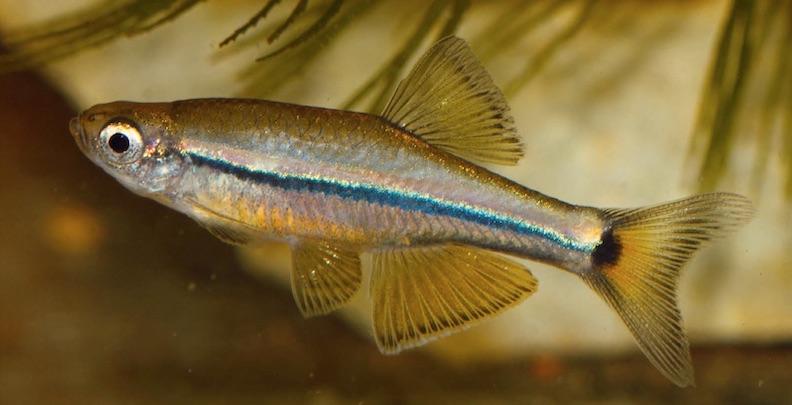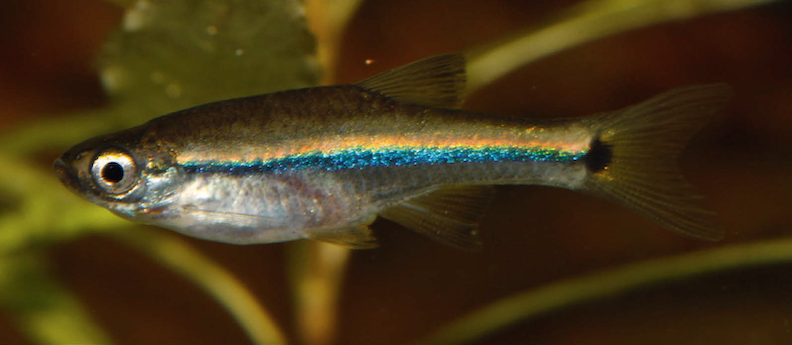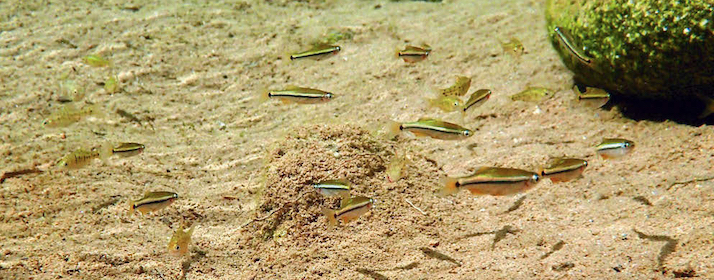
Male Tanichthys kuehnei from the Vietnamese stream Rach Hoi Da. Photo by J. Kühne. Published in Bohlen et al. 2019.
Years in the making, a fourth species has been officially described in the Asian cyprinid genus Tanichthys. This summer a team of four authors, Jörg Bohlen, Tomáš Dvorák, Ha Nam Thang and Vendula Šlechtová, published the description of Tanichthys kuehnei in the journal Ichthyological Exploration of Freshwaters.
Tanichthys kuehnei were first exported from the Bach Ma Mountains in central Vietnam into the hobby in 2009 as an undescribed species and sold under the names Tanichthys sp. ‘Vietnam’, Tanichthys sp. ‘lemon’, and/or ‘yellow white cloud’. Unfortunately, it has also been erroneously sold under the epithet of its congener T. thacbaensis. Following its first introduction, ichthyologists and fish collectors alike searched in vain for years trying to recatch this elusive species. Finally in 2017, T. kuehnei was relocated in Hue Province in Central Vietnam, and voucher specimens were used to formally describe the species.
The genus Tanichthys was monotypic for nearly 70 years with T. albonubes (the White Cloud Mountain minnow) as its sole member hailing from China and northeast Vietnam. Tanichthys thacbaensis, an endemic species to Thac Ba Lake, Yen Bai Province in northwestern Vietnam, and T. micagemmae from central Vietnam, were described in 2001.
Tanichthys kuehnei is distinguished from all other Tanichthys by having 9.5 branched rays in its anal fin (vs. 7-8.5 in T. micagemmae and 8.5 in T. albonubes and T. thacbaensis). Another distinguishing feature is the presence of the black stripe that runs along the lateral midline (in T. kuehnei) as opposed to above the mid-lateral line (in T. albonubes and T. thacbaensis). Tanichthys kuehnei differs from T. micagemmae, its closest relative both genetically and geographically, by having a greater number of anal fin rays and white (opposed to red) margins in the anal fin.

Female Tanichthys kuehnei from the Vietnamese stream Rach Hoi Da. Photo by J. Kühne. Published in Bohlen et al. 2019.
The coloration of living specimens includes a light brown dorsal, a white belly, and two mid-lateral stripes, a black mid-lateral stripe highlighted with an iridescent blue and a white/orange mid-lateral stripe that is positioned directly above the dark stripe. Both sexes have a conspicuous black dot on the caudal-fin base and exhibit varying degrees and intensities of red coloration in the central area caudal fin and pelvic and anal fins. Males differ from females by having tubercles on the snout, longer anal-fin rays, and have more intense red coloration in anal and pelvic fins.
The type locality, a stream named Rach Hoi Da, had very clear water with a pH near 7 and very low conductivity at the time of collection. The biotope featured a sandy bottom with rocks and filamentous algae.
Who’s in the trade, T. kuehnei, T. thacbaensis, or T. sp. ‘Da Nang’?
Most likely, if you have a ‘yellow white cloud’ in your possession, it is T. kuehnei and not T. thacbaensis. There is a cloud (pun intended) of mystery behind the identity of T. thacbaensis as it was described from two individual specimens collected in 1962 from a location at Thac Ba. Shortly after collection, the type locality was inundated following the completion of the Thac Ba Reservoir. No T. thacbaensis has been found since the inundation and to further hamper comparisons, the type specimens have since been lost!
Ingo Seidel reported in a 2012 German edition of AMAZONAS that the species, Tanichthys sp. ‘Vietnam’ from Da Nang Province, is easy to keep and breed. Note that Da Nang is adjacent and to the south of Hue Province. Seidel’s Tanichthys sp. ‘Vietnam’ has the same diagnostics as T. kuehnei.
To add to the confusion, Friedrich Bitter also reported on a Tanichthys species caught in the area of Da Nang, Vietnam in the Nov/Dec 2018 issue of AMAZONAS. However unlike T. kuehnei and T. sp. ‘Vietnam’, the Tanichthys sp. ‘Da Nang’ kept by Bitter had 8 anal fin rays and a black mid-lateral line that appears to be above the fish’s midline.
We know from phylogenetic analyses that T. kuehnei is a valid species. What is yet to be determined is if the genus Tanichthys is limited to four species.
References
Bitter, F. 2018. Species Snapshots: Tanichthys sp. “Da Nang”. AMAZONAS 7(6): 95.
Bohlen, J., T. Dvorák, H.N. Thang, and V. Šlechtová. 2019. Tanichthys kuehnei, new species, from Central Vietnam (Cypriniformes: Cyprinidae). Ichthyol. Explor. Freshwaters 29(1): 9-18. http://doi.org/10.23788/IEF-1081
Seidel, I. 2012. Ein neuer Kardinalfisch aus Vietnam. AMAZONAS 41: 38-41.
The Nov/Dec 2018 issue of AMAZONAS containing Freidrich Bitter’s snapshot of Tanichthys sp. “Da Nang” is available to purchase through our Back Issues Shop.
Order AMAZONAS Nov/Dec 2018 Back Issue Here






Hello Dream Team! Best fishes, an artifact.